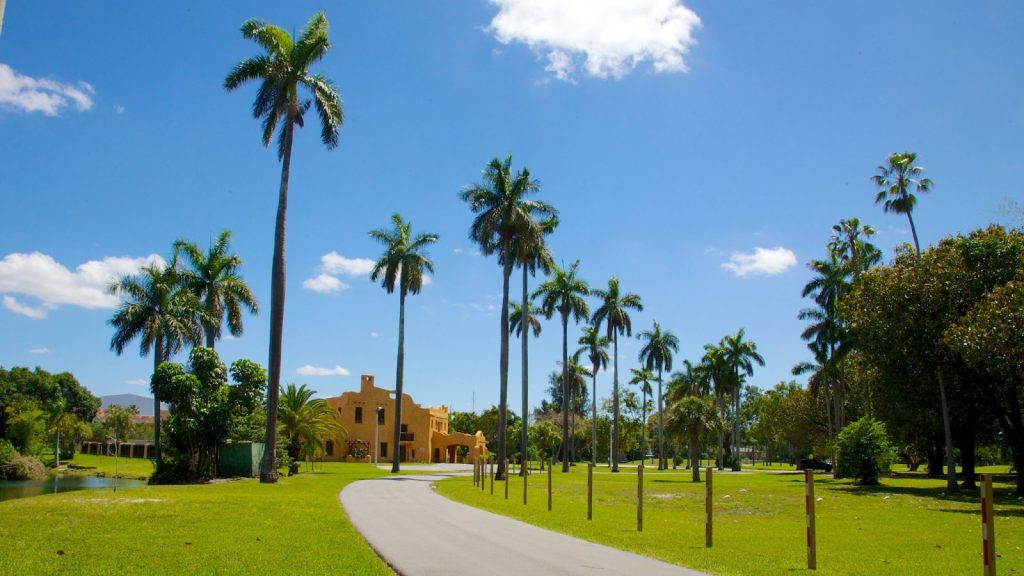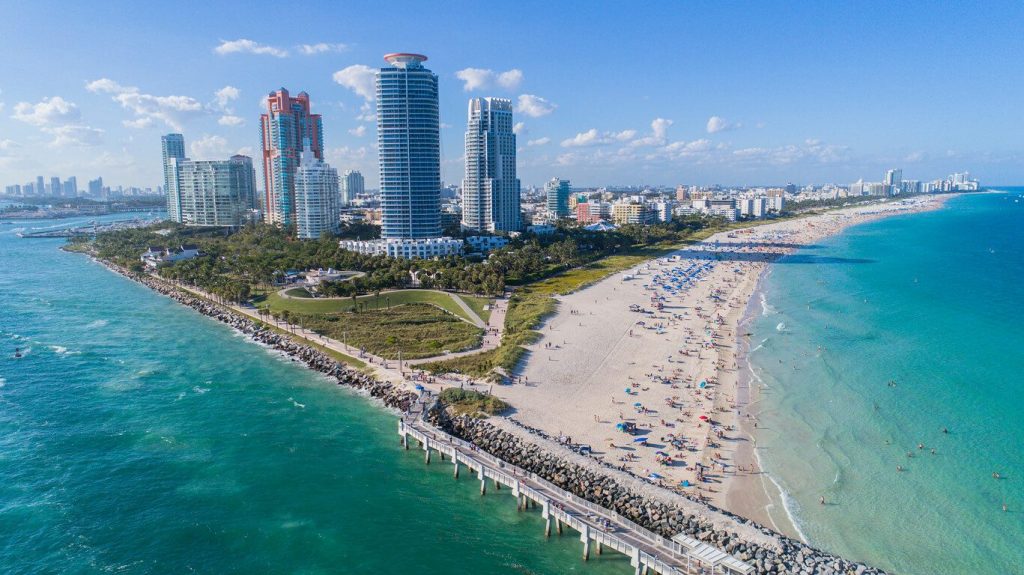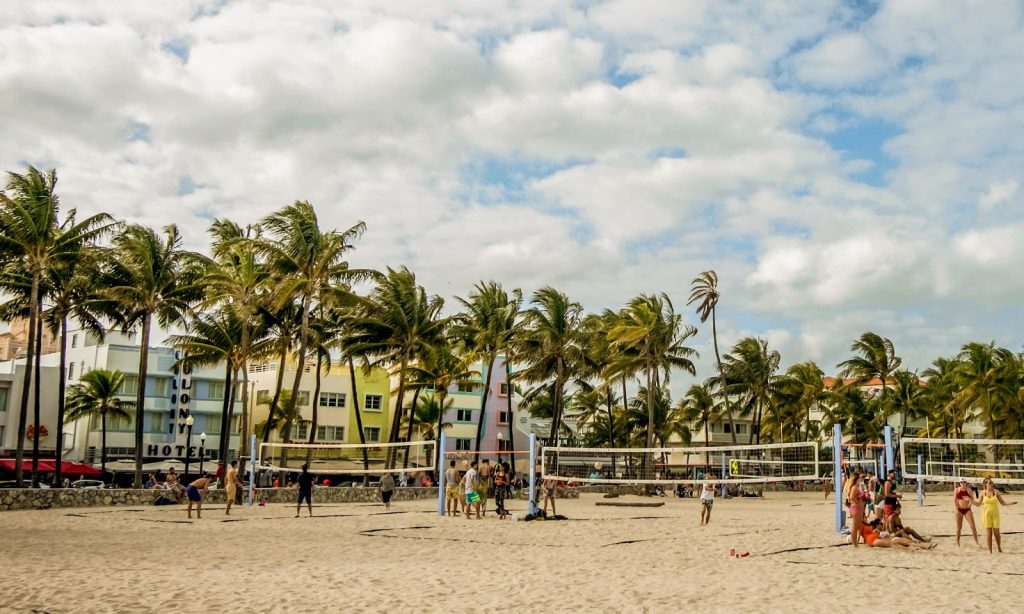Miami, a vibrant city located on the southeastern tip of Florida, is renowned for its white sandy beaches and crystal-clear waters that attract sun-seekers from around the globe.
Miami’s tropical monsoon climate, with hot summers, mild winters, and moderate rainfall, is a crucial factor in its attractiveness as a tourist destination.
This weather is ideal for outdoor activities like water sports, sight-seeing, and sunbathing throughout the year.
Despite being situated at approximately 25 degrees north latitude, Miami offers an ideal environment for thriving flora and fauna due to this warm climate.
With temperatures rarely dipping below 60°F (16°C) during winter months and averaging between 75°F (24°C) to 90°F (32°C) in summer months, tourists can enjoy lush greenery throughout their stay while observing diverse ecosystems such as marshes and mangroves.
Hurricane season in Miami is from June to November, but infrequent occurrences don’t significantly affect your overall travel experience.
Overview Of Miami’s Climate
Image Credit: Treksplorer
The climate of Miami, a vibrant coastal city in the southeastern United States, is classified as tropical monsoon (Am) according to the Köppen-Geiger climate classification system.
This type of climate is characterized by hot and humid summers with frequent thunderstorms and relatively mild winters with occasional cold fronts.
Weather on Miami Beach can vary from clear blue skies to sudden downpours within hours, making it essential for visitors to keep an eye on weather updates and forecasts during their stay.
To prepare for a visit to Miami, check reliable sources like local news stations or online platforms for current and predicted weather conditions.
By doing so, tourists will have better knowledge about potential heat waves, extreme rainfall events or even hurricanes which may affect their travel plans.
Understanding Miami’s weather patterns helps choose appropriate clothes and plan outdoor activities.
Spring In Miami

Image Credit: Expedia
Spring in Miami has unique characteristics that offer a pleasant experience for both visitors and residents.
As winter gives way to spring, the weather in Miami Beach becomes increasingly warmer and sunnier. March through May often boasts pleasant temperatures ranging from 70°F (21°C) to 82°F (28°C), making this season ideal for outdoor activities such as beach visits or strolls along Ocean Drive.
Miami’s spring has minimal rainfall, but occasional showers may occur, so it’s important to monitor the weather. Extended forecasts, like Miami’s 15-day weather forecast, can be useful for planning ahead.
Spring offers wonderful opportunities to enjoy all that the dynamic city has to offer before the heat of summer really arrives
Summer In Miami

Image Credit: Thetravnav
Summer in Miami is characterized by its hot and humid climate, attracting visitors from around the world who wish to experience the vibrant atmosphere of this coastal city.
During these months, weather in Miami Beach typically ranges from highs of 86-90°F (30-32°C) and lows of 75-78°F (24-26°C), with humidity levels often exceeding 80%.
The warmest month tends to be July, while June sees the most rainfall as part of the region’s wet season.
While frequent afternoon thunderstorms with heavy downpours occur, visitors can still enjoy outdoor activities such as swimming, sunbathing, and watersports along Miami’s pristine beaches.
Monitoring the weather and staying up-to-date with Miami”s 10-day forecast may be necessary. However, visitors should not let unpredictable rain showers discourage them from exploring this diverse city.
Aside from beachside attractions, Miami boasts numerous cultural institutions, shopping centers, fine dining establishments, and lively nightlife venues that cater to a wide range of interests.
Many popular tourist sites provide indoor alternatives during inclement weather conditions or extreme heat waves when seeking respite from the elements becomes necessary.
Despite some weather challenges in summer, Miami offers ample opportunities for enjoyment and entertainment as a dynamic urban destination.
Average Temperatures

Image Credit: Whereandwhen
Check Miami’s average temperatures throughout the year to plan your visit accordingly.
As a popular destination, Miami’s weather plays a significant role in shaping the overall experience for travelers.
A closer look at the weather Miami Beach has to offer reveals that annual temperatures tend to hover between 60°F (15°C) and 90°F (32°C), with July being the warmest month on average.
Tourists should check Miami’s 15-day and 30-day weather forecasts to prepare for any temperature fluctuations or extremes during their visit and fully enjoy the city.
Rainfall

Image Credit: Timeout
Miami’s rainfall significantly impacts the overall experience of this vibrant, tropical paradise.
Weather in Miami Beach and surrounding areas can often be unpredictable due to frequent showers that punctuate sunny days with bouts of refreshing rain.
The climate’s dual nature offers a unique blend of sunshine and precipitation, which contributes to the lush greenery enveloping the city.
Monitoring Miami weather hourly through forecasts or radar apps is useful for tourists and residents to plan their activities.
Real-time weather information helps people adapt by seeking shelter during rain or continuing outdoor activities when it clears up.
Understanding Miami’s rainfall helps visitors fully enjoy the city and ensures a comfortable stay.
Humidity

Image Credit: Airbnb
Humidity plays a significant role in shaping the overall experience of weather in this coastal city.
As part of a tropical monsoon climate, it comes as no surprise that Miami experiences high humidity throughout the year, with an average relative humidity typically ranging between 60% and 80%.
High humidity causes sticky and muggy conditions, especially in summer when it’s hot.
Humidity can be studied by looking at examples like Miami Beach weather or checking Miami’s hourly weather data.
By doing so, travelers can better anticipate changes in conditions and plan their activities accordingly.
Keep tracking Miami’s weather tomorrow to adjust plans if there are unexpected changes.
Overall, understanding how factors like humidity contribute to Miami’s distinct climate ensures a smoother travel experience.
Hurricanes

Image Credit: Cnbcfm
The tropical climate of Miami is often accompanied by the looming threat of hurricanes, which can significantly impact the region’s weather patterns.
The Atlantic hurricane season typically lasts from June 1st to November 30th, with peak activity occurring between August and October.
Tourists and residents must monitor local forecasts and Miami weather radar for potential risks to safety or travel plans.
Besides official channels like news outlets and National Hurricane Center, people in Miami Beach should know emergency preparedness measures for powerful storms.
Prepare for a hurricane by having an evacuation plan, non-perishable food and water, securing outdoor items, and staying updated on Miami weather hourly updates.
By taking these steps proactively, visitors and locals can better adapt to sudden changes in weather conditions while protecting themselves from potentially dangerous circumstances.
Best Time To Visit
Image Credit: Travellersworldwide
The best time to visit Miami varies depending on weather preferences. Warm temperatures prevail throughout the year due to its tropical climate. The optimal time to visit Miami depends on factors like rainfall, humidity levels, and ocean temperatures.
By examining aspects like the weather in Miami Beach over a 10-day period or utilizing a Miami 15-day forecast, prospective visitors can better plan their trips accordingly.
Typically, the best time to visit Miami is during the dry season from November through April when rain is less frequent, and average high temperatures range between 75°F (24°C) and 80°F (27°C). During this period, one can enjoy pleasant beach days and experience comfortable outdoor activities without oppressive heat or excessive precipitation.
Check detailed forecasts before traveling to Miami, but understanding general weather patterns can help make informed decisions about when to go.
Clothing Recommendations

Image Credit: Townandtourist
Miami Beach has beautiful sun-kissed shores, but weather conditions can quickly turn pleasant walks into discomfort if you’re not prepared.
To have a good time in Miami, wear suitable clothes according to reliable forecasts like the weather in Miami for 10 days or hourly predictions. Consider factors like temperature, humidity, and precipitation.
For instance, during summer months when heat and humidity reach their peak, lightweight and breathable fabrics like cotton or linen will provide optimal comfort while exploring the vibrant city streets or lounging by the beachside. Conversely, winter evenings may need additional layers such as light jackets or sweaters due to cooler temperatures.
As sudden showers are frequent in Miami all year round, it is advisable to pack an umbrella or waterproof coat. Visitors can enjoy their trip without any wardrobe concerns by planning for the climate.
Frequently Asked Questions
What is the best month to go to Miami?
Best time to visit Miami, Florida depends on preferences. Winter months (Dec-Feb) offer pleasant weather, lower humidity, and cooler temps. Spring (Mar-May) has warm weather and cultural events. Summer (Jun-Aug) is hot and humid with beach activities and festivals. Fall (Sep-Nov) has warm temps and fewer tourists.
Is Miami hot or cold?
Miami, Florida has a tropical monsoon climate with hot, humid summers and mild, dry winters. The city generally experiences warm to hot temperatures throughout the year, with average high temperatures ranging from the 70s to 90s°F (20s to 30s°C), making it a popular destination for beach-goers and outdoor activities.
Has Miami ever hit 100 degrees?
Miami, Florida has not recorded an official temperature of 100 degrees Fahrenheit (37.8 degrees Celsius) in its history. The highest recorded temperature in Miami was 98 degrees Fahrenheit (36.7 degrees Celsius), which occurred on July 21, 1942.
Has it ever snowed in Miami?
Miami, Florida has never had snow due to its tropical climate and location in South Florida, with mild winters and hot summers being the norm.
